By Eileen E. Fabian & Elizabeth Hines
Providing housing to swine in cold winter weather includes the decision as to whether to modify the barn environment to keep it warm or to let the indoor temperature be similar to outside conditions.
Many specialty market or private use pig producers opt for housing swine in barns at least part of the year, often during the winter. Providing housing to swine in cold winter weather includes the decision as to whether to modify the barn environment to keep it warm or to let the indoor temperature be similar to outside conditions.
The distinction between these facilities is observed during cold winter weather, when farm animals (especially pigs) need the most protection. This article outlines issues that help in decision making for pig welfare and economics related to warm and cold housing. It should be noted that commercial pork producers typically house the animals year-round in climate-controlled facilities.
Cold Housing
Cold housing is a barn environment that is left to its own devices to be the same temperature as outdoors; so cold in the winter. It will essentially be the same temperature as outside conditions, while providing protection to enclosed animals from the worst of winter weather winds and precipitation.
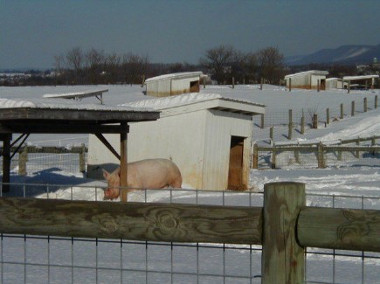
Warm Housing
Warm housing, also known as "modified environment" or "climate controlled," needs to have additional heat supplied in order to remain above cold outdoor conditions. The heat is referred to as "supplemental" heat since it is supplied to supplement heat already produced by pig body heat within the housing unit or barn. Supplemental heat is typically from electricity or fossil fuel sources via space heaters or radiant heat units.
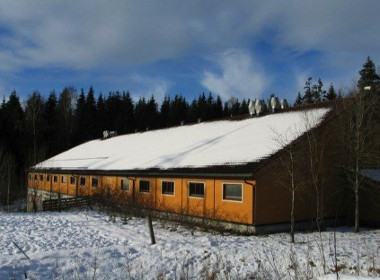
Temperature needs varies for young and mature pigs
Swine have a very narrow thermo-neutral zone; you could call this a comfortable temperature range for pigs.
Mature pigs can handle cooler temperatures than immature and growing pigs; however, once those temperatures fall below 40°F for adult swine, the ability to add further protection from the cold is a must. Mature swine can adapt to winter temperatures, however this is commonly at the expense of body condition, see Principles of body condition scoring in swine .
Growing pigs (birth to about 6 months), however, do not yet have the physical capacity to adequately withstand temperatures much below 50°F. Warm housing, with heat from a sow and/or supplemental heat source, is necessary for animal welfare and growth efficiency of pigs smaller than 200 lbs.
Suggested temperatures are found in Table 1. But there may be reasons beyond what the animals can tolerate to prefer warm housing versus cold. More on that a bit later. Knowing the thermo-neutral zone that is appropriate for the pigs you are growing will aid housing decisions.
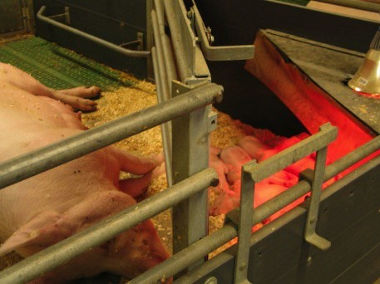
Healthy barn needs adequate ventilation
Pig welfare while in a barn environment is highly dependent upon providing good air quality. Cold and warm housing both must have good ventilation via incoming fresh air with removal of stale, moisture-laden air to maintain healthy and productive animal environments. At least a "minimum" ventilation rate is needed even during the coldest weather to maintain good air quality. This is the same for both housing types. But ventilation is supplied and managed differently depending on the cold versus warm environment. Ventilation rates may be found in Table 1 and Additional Resources.
Several differences between warm and cold housing ventilation are worth noting. Warm housing environment is usually "power" or mechanically ventilated with a computer-controlled system of sensors, fans and inlets in a tightly constructed, well-insulated structure. This sounds more expensive, and is, yet can offer cold weather and year-round ideal conditions for swine comfort. Cold housing is typically naturally ventilated by wind, with or without electronic controllers, and may be an uninsulated or lightly insulated structure.
Offsetting costs of warm and cold environment
One cost of the warm environment becomes quickly obvious, and that is the supplemental heat in the form of electricity or propane (etc.). Maintaining good air quality means that this heated air, which has gathered moisture, manure gases and any pathogens from within the animal area, will be exchanged with cold, but fresh, air that then needs to be heated. This fuel cost is offset by the improved feed efficiency of animals kept in warm, thermo-neutral, conditions. Mature pigs kept in cold housing will require more feed to produce their own heat needed just to maintain body temperature. Growing pigs will struggle to grow, will likely become ill, and possibly die if left in cold housing.
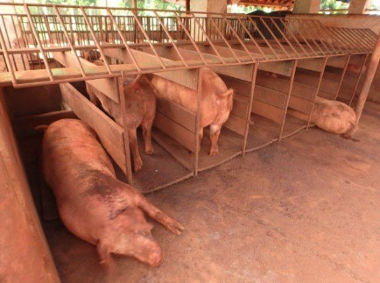
Management temptations during cold weather
Managers of either warm or cold facilities need to resist the temptation to trap animal body heat by restricting proper ventilation to maintain warmer conditions. In this scenario, by under-ventilating the barn one traps animal body heat, which seems to be a smart decision to save on the amount of supplemental heat needed to maintain the same temperature. Unfortunately, we cannot just trap the animal body heat without other materials also accumulating in the poorly ventilated barn, such as moisture, manure gas and other air contaminants (i.e. disease vectors, feed, dust from feed, bedding and dander [a.k.a. particulate matter], carbon dioxide).
Under-ventilation also results in high humidity and condensation, which is detrimental to the structure, equipment, and creates an unhealthy condition that favors the growth of mildew, bacteria and some disease vectors. Not to mention trapping foul odors and gases from urine and feces. Cold, damp conditions found in under-ventilated shelters are more chilling and stressful to swine than cold conditions if kept dry with fresh air exchange. It is very important to provide fresh air ventilation even during the coldest weather, at least at the minimum rate, to maintain good air quality.
Overcoming cold housing challenges
Freezing conditions in cold housing will need to be addressed. If the interior temperature of a properly ventilated cold shelter is within 5-10°F of outdoor temperature, then the water supply will need to be protected from freezing and waste management will need to accommodate the potential for frozen manure. Bedding is needed in cold housing, as that allows animals to snuggle down and create a micro-environment of warmer conditions.
This said, soiled bedding should be changed out routinely or plan on frequent additions of a layer of fresh dry bedding in order to maintain insulative properties. Dry bedding has good heat insulation properties; damp or wet bedding does not. Barn and pen designs that encourage pigs to "bathroom" in a limited area(s) help with maintaining a dry resting area.
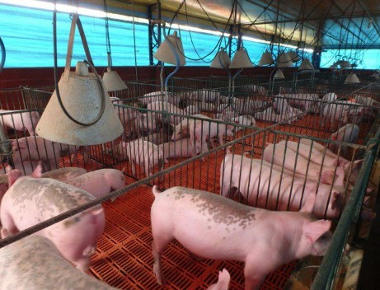
What about hot weather?
The warm and cold housing designation refer to winter conditions, yet swine may be indoors year-round. Either housing should then have hot-weather ventilation and perhaps affiliated features (evaporative cooling, for example). This hot weather ventilation is often a separate system.
Summary
Housing decisions must be based first on animal welfare and comfort and this often favors warm housing for young pigs, whereas well managed cold housing can work for mature pigs. Managers must decide between tight control of temperature and air quality conditions (warm housing) or no temperature control, yet well-ventilated conditions, for cold housing.
Warm housing has the additional cost of a more sophisticated ventilation system and supplemental heat to maintain comfortable warmer temperatures than cold housing. The shelter itself will be designed for natural ventilation (cold housing) or mechanical ventilation (typically, warm housing) or be able to seasonally accommodate either.
The decision to keep pigs in cold or warm housing is also an economic one with warm housing being more expensive to construct and operate yet offsetting this with improved pork production costs in cold climates.
Table 1: Recommended cold weather ventilation rates and room temperatures for swine.
Adapted from MWPS-8 Swine Housing and Equipment Handbook.
| | Unit (lb) | Cold Weather (cfm/unit) | Preferred Winter Room
Temperature (°F) |
|---|
| Sow and Litter | 400 | 20 | 60-80 |
| Prenursery pig | 12-30 | 2 | 85 |
| Nursery pig | 30-75 | 3 | 65-75 |
| Growing pig | 75-150 | 7 | 60 |
| Finishing pig | 150-220 | 10 | 60 |
| Gestating sow | 325 | 12 | 60 |
| Boar | 400 | 14 | 60 |
Source: psu.edu